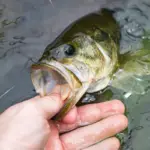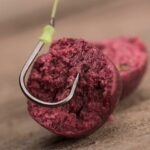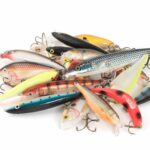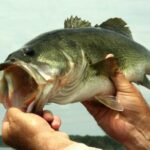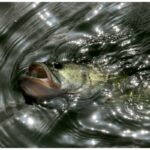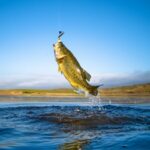A lot of anglers have wondered what largemouth bass eat. This is because if we can understand what their diet consists of, then we may be able to improve our chances of catching a bass the next time we go fishing.
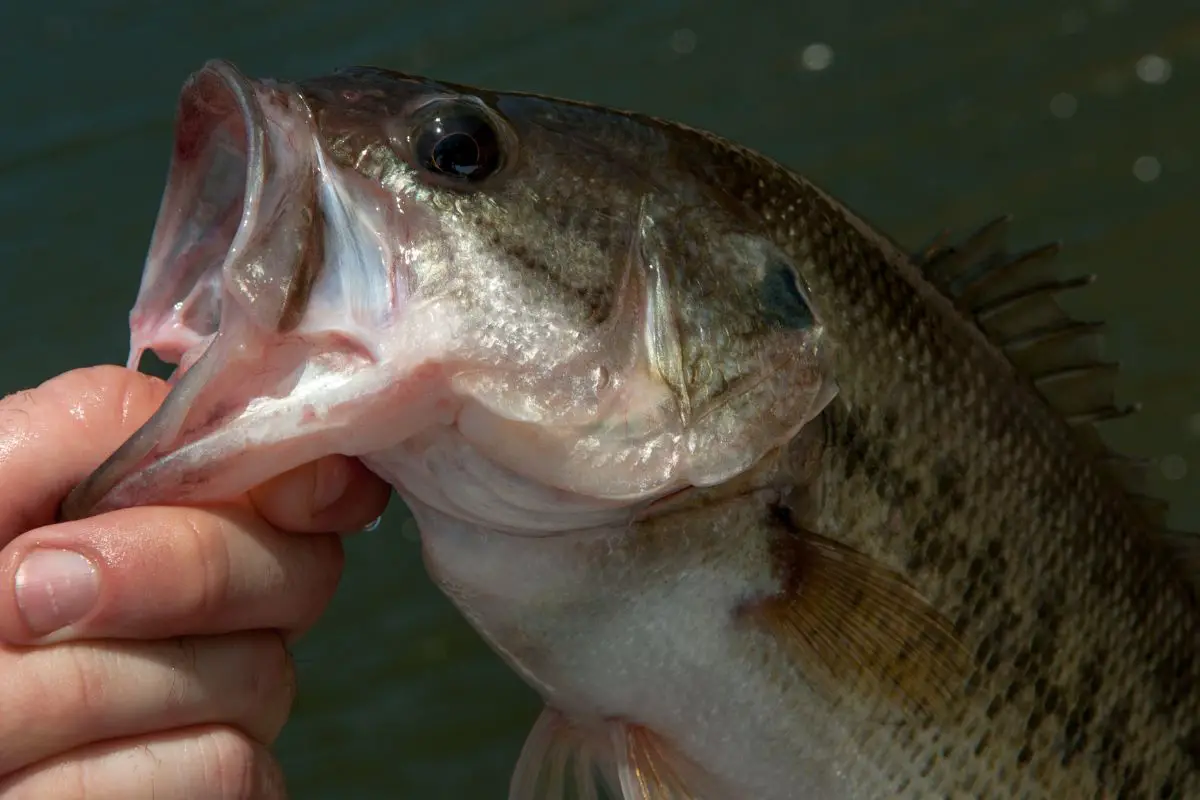
In this article, we will be discussing what bass eat and what their diet throughout the year looks like. We will then go into detail on the 5 best live baits you should be using, to help you try and catch as many basses as possible.
The Largemouth Bass And Their Predatory Behavior
To really understand what a bass will eat, we need to first understand what their predatory behavior is like, which will showcase what kind of diet they live off.
The predatory behavior of a largemouth bass will generally take one of the following three forms.
Ambush
In the majority of cases, you will see that a bass is more than likely going to ambush their prey. This will be from hiding in dense cover such as brush piles, vegetation or submerged lay-downs.
Then their prey unsuspectingly swims past, the bass will emerge from their hiding spot and attack.
Some form of dense cover is preferred by bass, as it attracts forage and baitfish.
Hunt
Typically, you will find larger and lone bass roaming around in very shallow water. However, this water needs to have plenty of cover for them. They will roam this water looking for food.
When they are hunting, they can suspend temporarily in a water column. This looks like the bass has shut down, but in this state they are fully aware of any forage and will eat when the opportunity arises.
Chase
This mode is commonly seen in groups of bass, it is also associated with schooling behavior. The group of bass will discover a group of baitfish. All the bass in the group will attack the baths at once and eat large amounts of bait fish as they do this.
This attack is cleverly thought out, as the group of bass will attack the bait fish with a series of strikes.
Then, once the group of baitfish has dispersed, the group of bass will swim through that area and eat any of the stunned or dying baitfish that have been left behind.
What Does The Diet Of A Largemouth Bass Consist Of?
When we look at the eating behavior of a bass, it is all to do with instincts. The two main goals of a largemouth bass are spawning and eating. They can’t really afford to pass up the chance to eat when they are given it.
Generally, it is known that bass like to eat small aquatic forage, while they are still at a young age.
Phil Hickley in 1994 and Schindler et al in 1997, along with their colleagues, have completed several studies around the diet of the largemouth bass. These studies confirmed what a lot of anglers have already known and followed for years.
The Diet Of A Bass Will Change With Age
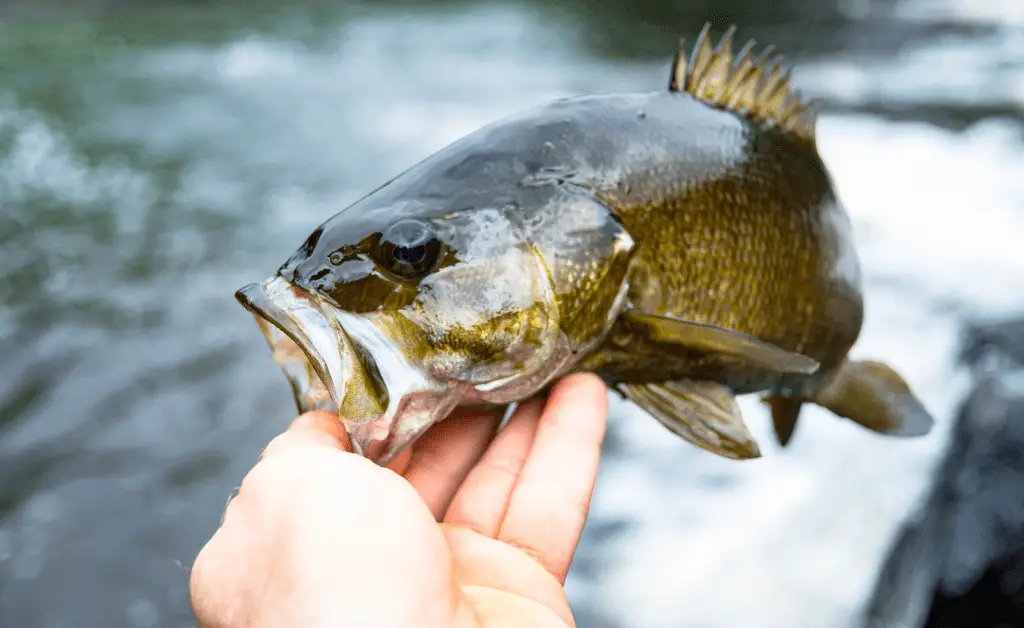
Bass will generally eat anything that will fit into their mouths. Therefore, their diet will change as they age and grow because the size of their mouth will begin to grow.
Thus, as their mouths get bigger, they can begin to consume prey that is much bigger as well.
What Do Younger Bass Eat?
Younger bass have much smaller mouths, so they can only consume smaller prey, until their mouths grow. In addition, they will stay close to their hatching and spawning area, until they are old enough to move on.
For young bass, their diet varies, but mainly consists of small tadpoles, insects, zooplankton and minnows. As they begin to grow, the bass’s diet will change, and they will start to consume more leeches, terrestrial insects and worms.
Once a largemouth bass reaches around 6 inches in length, it will begin to feed on small food, including underwater insects and larger minnows.
What Does An Older Bass Diet Consist Of?
Once a largemouth bass has grown to around 12 inches in length, their diet will change once again. Now their diet will begin to be full of fish like perch, small bluegill, shad, suckers, and shires. At this length, bass will begin consuming crayfish, if it is present.
Once a bass gets rear to 3 to 4 pounds in weight, their diet will change again. They will start to eat much larger fish, like larger bluegill and adult shad. In addition to this, adult bass will gladly be cannibals and eat younger bass, if they are hungry.
Also, once an adult bass reaches this weight range, they also begin to get a taste for snakes, frogs and any creatures that happen to fall into the water.
How Does A Bass Diet Change During The Seasons?
Just like with humans, the time of year can affect what a bass will eat and how much they can eat. Feeding for a bass is affected by the time of year, as it depends on the mating habits of the bass and the temperature of the water.
Once the temperature of the water drops, this then affects what a bass will eat and how much they can eat.
What Will A Bass Eat During The Spring And Summer?
The diet of a bass in the spring and summer will vary depending on the location of the pond, river or lake. Spawning of bass can begin in the very early spring. Yet, bass found in northern waters will spawn at a later date.
For bass, they will go through a phase known as pre-spawn. This is when the bass move away from the main lake into their bedding area. During this period, the bass will feed on crayfish and shad fish.
This is so the bass fish can gain plenty of nutrients that are needed in preparation for a fasting period, which usually happens while the bass fish guard their nest.
Female bass will remain in the nest, and male bass will stay nearby the nest and patrol the area. During this time, their thoughts are about watching over their nest and not on food.
When bass are patrolling their nest, they can become extremely aggressive. They are known to strike and attack anything that comes near them.
If you place a jig or worm near the edge of their nesting bed, you will certainly always get a reaction from the bass protecting their nest. This attack will either come from the aggressive male bass in the area, or the overly protective female on the nest.
When we get into summer, spawning is over and both male and female bass can go back to their feeding. During the spring and summer, bass have a lot to choose from when it comes to their diet. This includes frogs, shad and bluegills.
What Will A Bass Eat During The Fall And Winter?
It’s actually known that in the fall, there is a sudden surge with bass hunting as they try to hunt more to eat more, so they can fatten up for the winter months.
For bass that are still in shallower water, they can carry on hunting for frogs, bluegills and crawfish, before the forage becomes less active, and it becomes too cold.
Then once winter is here, bass will swim into much deeper water, and will focus on hunting shad fish.
During the winter, bass will typically suspend themselves in open water near a structure or a drop-off, where they have an opportunity to eat when food becomes within range.
The slightest changes in temperature can affect the behavior of bass. Generally, in winter they will hunt at the warmest points of the day, this is due to the warmer water triggers the fish to become a lot more active.
The Best Baits For Bass
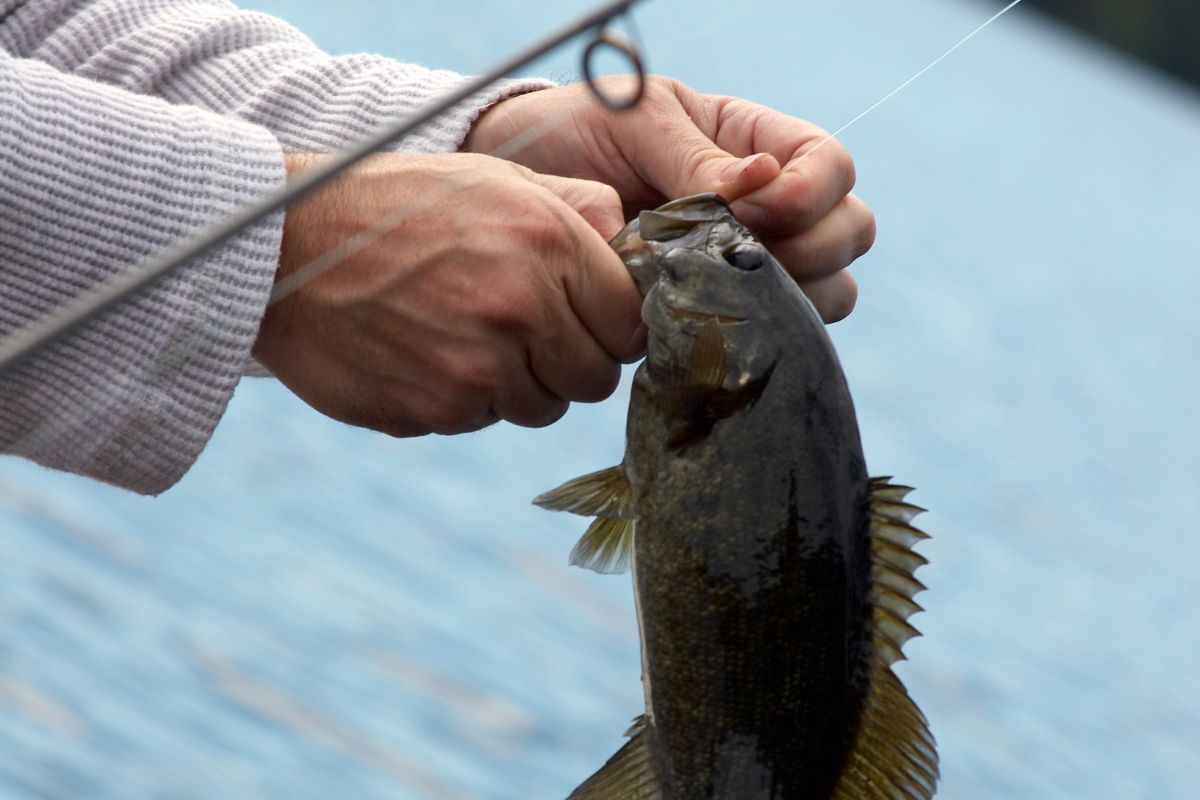
When it comes to the best bait to use to catch fish, you should try to use their favorite foods, which includes: mice, crawfish, frogs, and baitfish.
In this section, we will be taking a look at some of the foods that you can use when trying to hook a bass. We aren’t going to talk about artificial baits, as there are thousands of lures on the market, we are looking at natural baits instead.
Baitfish
Using baitfish is a really easy way to attract bass to your line. The most common type of bait fish you may see in rivers or lakes is the shad.
If you see a school come to the surface, then throw out your cast net and capture them. That’s the easy part, the hard part is keeping them alive.
Shad need to be kept in particular water conditions. Therefore, if you can keep the shad alive, casting shad into shallow or medium depth water will ensure you can hook a bass.
Although, if the baitfish dies, then you can use the dead shad to fish for catfish.
Crawfish
Bass enjoy eating crawfish. If you happen to catch a crawfish, it is really easy to keep them alive. To use a crawfish as bait, you need to insert your hook through the rear area of their back or insert the hook on the underside of the crawfish.
After that, the crawfish will live just long enough to create vibrations in the water to attract the bass.
Bluegill
Bluegill is a really easy bait to get a hold off. Using your cast net, you can collect large volumes of bluegill that will be more than enough to attract a bass. Or you can fish for the bluegill instead, using tiny baits and light gear.
Once you catch a bluegill, they are really easy to keep alive. Unlike the shad, you don’t need to take any extra steps to keep them alive.
Ideally, you want to try and catch small to medium-sized bluegills.
Mice And Frogs
Basses love to eat snakes, frogs, mice and bumblebees. Any creature that makes vibrations on the surface of the water, will attract a bass.
However, we know that not many of us really want to push a hook through a mouse, bee or snake. This is why various artificial lures are a better option, if you want to imitate a creature on the water.
This is known as topwater fishing, which is a really popular and effective method when it comes to catching bass. The two most popular lures are those that look like struggling baitfish, or frog baits.
Every tackle store will have various lure options for you to choose from.
There are even baits and lures that look like full sized snakes, young ducks and mice. If you get the right conditions, then you may be able to make a bass think it is about to get a really rewarding meal.
Which Creatures Will Eat Bass?
Bass aren’t safe from being eaten by other creatures. As we mentioned above, bass are cannibals, and the larger bass will eat younger bass that they come into contact with. Alongside that, catfish and striped bass will also eat juvenile bass as well.
Certain fish eating birds like osprey and herons are known to eat bass. While also, turtles will gladly eat a bass that gets too close to them. Finally, bass are fished for and eaten by humans too. There are many things that will eat a bass.
Final Thoughts
As you can see, bass have quite a varied diet. They will eat a lot of fish, and they also enjoy creatures that land on the surface of the water, such as frogs and snakes.
You have plenty of options to choose from when it comes to choosing the best live baits to catch a bass.
We hope you enjoyed this article, and you now know 5 live baits to use, next time you want to hook a bass.
- Do You Need An Indicator For Nymph Fishing? - November 16, 2023
- Fishing Safety Tips For Families - September 25, 2023
- What Is The Best Time To Night Fish At A Lake? - September 18, 2023


